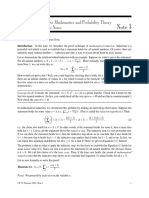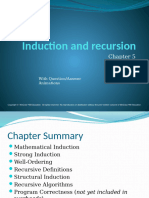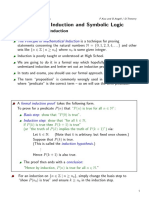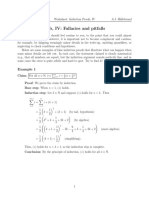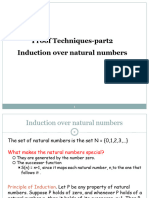cs70-2 Notes3 PDF
cs70-2 Notes3 PDF
Uploaded by
huayongliCopyright:
Available Formats
cs70-2 Notes3 PDF
cs70-2 Notes3 PDF
Uploaded by
huayongliOriginal Title
Copyright
Available Formats
Share this document
Did you find this document useful?
Is this content inappropriate?
Copyright:
Available Formats
cs70-2 Notes3 PDF
cs70-2 Notes3 PDF
Uploaded by
huayongliCopyright:
Available Formats
CS 70-2 Discrete Mathematics and Probability Theory
Fall 2009 Satish Rao,David Tse Note 3
Induction
Induction is an extremely powerful tool in mathematics. It is a way of proving propositions that hold for all
natural numbers:
k(k+1)
1) ∀k ∈ N, 0 + 1 + 2 + 3 + · · · + k = 2
2) ∀k ∈ N, the sum of the first k odd numbers is a perfect square.
3) Any graph with k vertices and k edges contains a cycle.
Each of these propositions is of the form ∀k ∈ N P(k). For example, in the first proposition, P(k) is the
statement 0 + 1 + · · · + k = k(k+1)
2 , P(0) says 0 =
0(0+1)
2 , P(1) says 0 + 1 =
1(1+1)
2 , etc. The principle of
induction asserts that you can prove P(k) is true ∀k ∈ N, by following these three steps:
Base Case: Prove that P(0) is true.
Inductive Hypothesis: Assume that P(k) is true.
Inductive Step: Prove that P(k + 1) is true.
The principle of induction formally says that if P(0) and ∀n ∈ N (P(n) =⇒ P(n + 1)), then ∀n ∈ N P(n).
Intuitively, the base case says that P(0) holds, while the inductive step says that P(0) =⇒ P(1), and P(1) =⇒
P(2), and so on. The fact that this domino effect eventually shows that ∀n ∈ N P(n) is what the principle of
induction (or the induction axiom) states. In fact, dominoes are a wonderful analogy: we have a domino for
each proposition P(k). The dominoes are lined up so that if the k th domino is knocked over, then it in turn
knocks over the k + 1st . Knocking over the kth domino corresponds to proving P(k) is true. So the induction
step corresponds to the fact that the k th domino knocks over the k + 1st domino. Now, if we knock over the
first domino (the one numbered 0), then this sets off a chain reaction that knocks down all the dominoes.
Let’s see some examples.
k
k(k + 1)
Theorem: ∀k ∈ N, ∑i = 2
.
i=0
Proof (by induction on k):
0
0(0 + 1)
• Base Case: P(0) asserts: ∑i = 2
. This clearly holds, since the left and right hand sides both
i=0
equal 0.
CS 70-2, Fall 2009, Note 3 1
k
k(k + 1)
• Inductive Hypothesis: Assume P(k) is true. That is, ∑i = 2
.
i=0
k+1
(k + 1)(k + 2)
• Inductive Step: We must show P(k + 1). That is, ∑i= 2
:
i=0
k+1 k
∑ i = ( ∑ i) + (k + 1)
i=0 i=0
k(k + 1)
= + (k + 1) (by the inductive hypothesis)
2
k
= (k + 1)( + 1)
2
(k + 1)(k + 2)
= .
2
Hence, by the principle of induction, the theorem holds. ♠
Note the structure of the inductive step. You try to show P(k + 1) with the assumption that P(k) is true. The
idea is that P(k + 1) by itself is a difficult proposition to prove. Many difficult problems in computer science
are solved by breaking the problem into smaller, easier ones. This is precisely what we did in the inductive
step: P(k + 1) is difficult to prove, but we were able to recursively define it in terms of P(k).
We will now look at another proof by induction, but first we will introduce some notation and a definition
for divisibility. We say that integer a divides b (or b is divisible by a), written as a|b, if and only if for some
integer q, b = aq.
Theorem: ∀n ∈ N, n3 − n is divisible by 3.
Proof (by induction over n):
• Base Case: P(0) asserts that 3|(03 − 0) or 3|0, which is clearly true (since 0 = 3 · 0).
• Inductive Hypothesis: Assume P(n) is true. That is, 3|(n 3 − n).
• Inductive Step: We must show that P(n + 1) is true, which asserts that 3|((n + 1) 3 − (n + 1)). Let us
expand this out:
(n + 1)3 − (n + 1) = n3 + 3n2 + 3n + 1 − (n + 1)
= (n3 − n) + 3n2 + 3n
= 3q + 3(n2 + n), q ∈ Z (by the inductive hypothesis)
2
= 3(q + n + n)
Hence, by the principle of induction, ∀n ∈ N, 3|(n 3 − n). ♠
The next example we will look at is an inequality between two functions of n. Such inequalities are useful
in computer science when showing that one algorithm is more efficient than another. Notice that for this
example, we have chosen as our base case n = 2, which is natural because the claim we are aiming to prove
holds for all natural numbers greater than or equal to 2. If you think about the underlying induction principle,
CS 70-2, Fall 2009, Note 3 2
it should be clear that this is perfectly valid, for the same reason that standard induction starting at n = 0 is
valid (think back again to the domino analogy, where now the first domino is domino number 2). 1
Theorem: ∀n ∈ N, n > 1 =⇒ n! < nn .
Proof (by induction over n):
• Base Case: P(2) asserts that 2! < 22 , or 2 < 4, which is clearly true.
• Inductive Hypothesis: Assume P(n) is true (i.e., n! < n n ).
• Inductive Step: We must show P(n + 1), which states that (n + 1)! < (n + 1) n+1 . Let us begin with
the left side of the inequality:
(n + 1)! = (n + 1) · n!
< (n + 1) · nn (by the inductive hypothesis)
n
< (n + 1) · (n + 1)
= (n + 1)n+1
Hence, by the induction principle, ∀n ∈ N, if n > 1, then n! < n n . ♠
In the middle of the last century, a colloquial expression in common use was ”that is a horse of a different
color”, referring to something that is quite different from normal or common expectation. The famous
mathematician George Polya (who was also a great expositor of mathematics for the lay public) gave the
following proof to show that there is no horse of a different color!
Theorem: All horses are the same color.
Proof (by induction on the number of horses):
• Base Case: P(1) is certainly true, since with just one horse, all horses have the same color.
• Inductive Hypothesis: Assume P(n), which is the statement that n horses all have the same color.
• Inductive Step: Given a set of n + 1 horses {h 1 , h2 , . . . , hn+1 }, we can exclude the last horse in the set
and apply the inductive hypothesis just to the first n horses {h 1 , . . . , hn }, deducing that they all have
the same color. Similarly, we can conclude that the last n horses {h 2 , . . . , hn+1 } all have the same
color. But now the “middle” horses {h 2 , . . . , hn } (i.e., all but the first and the last) belong to both of
these sets, so they have the same color as horse h 1 and horse hn+1 . It follows, therefore, that all n + 1
horses have the same color. Thus, by the principle of induction, all horses have the same color. ♠
Clearly, it is not true that all horses are of the same color, so where did we go wrong in our induction
proof? It is tempting to blame the induction hypothesis. But even though the induction hypothesis is false
(for n ≥ 2), that is not the flaw in the reasoning! Before reading on, think about this and see if you can
understand why, and figure out the real flaw in the proof.
What makes the flaw in this proof a little tricky to pinpoint is that the induction step is valid for a “typical”
value of n, say, n = 3. The flaw, however, is in the induction step when n = 1. In this case, for n + 1 = 2
horses, there are no “middle” horses, and so the argument completely breaks down!
1 Alternatively,we could insist on making the base case n = 0 (which holds vacuously here because 0 > 1 is false). Then we
would assert that P(0) =⇒ P(1), since P(1) holds (vacuously again), and that P(1) =⇒ P(2) since P(2) holds (as we show in the
base case below). Then we would proceed as in the inductive step of the proof below. But this is all rather tedious.
CS 70-2, Fall 2009, Note 3 3
Some of you might still not feel completely convinced. Why is the above flaw more convincing than simply
saying that the induction hypothesis is false? Saying that the induction hypothesis is false is like saying
that the statement of the theorem is false, and so there is definitely a flaw in the proof. True, but our
task was to pinpoint exactly where in the proof the flaw occurs. The point is that a valid induction proof
involves only showing the base case, say P(0), and that ∀n P(n) =⇒ P(n + 1). One way of saying that
P(n) =⇒ P(n + 1) is to assume P(n) is true and then show that P(n + 1) is true. If P(n) is false, then
P(n) =⇒ P(n + 1) vacuously. So just saying that the induction hypothesis P(n) is false does not pinpoint
the flaw in the proof.
Two Color Theorem: There is a famous theorem called the four color theorem. It states that any map can
be colored with four colors such that any two adjacent countries (which share a border, but not just a point)
must have different colors. The four color theorem is very difficult to prove, and several bogus proofs were
claimed since the problem was first posed in 1852. It was not until 1976 that the theorem was finally proved
(with the aid of a computer) by Appel and Haken. (For an interesting history of the problem, and a state-of-
the-art proof, which is nonetheless still very challenging, see www.math.gatech.edu/∼thomas/FC/fourcolor.html).
We consider a simpler scenario, where we divide the plane into regions by drawing straight lines. We want
to know if we can color this map using no more than two colors (say, red and blue) such that no two regions
that share a boundary have the same color. Here is an example of a two-colored map:
We will prove this “two color theorem” by induction on n, the number of lines:
• Base Case: Prove that P(0) is true, which is the proposition that a map with n = 0 lines can be can be
colored using no more than two colors. But this is easy, since we can just color the entire plane using
one color.
• Inductive Hypothesis: Assume P(n). That is, a map with n lines can be two-colored.
• Inductive Step: Prove P(n + 1). We are given a map with n + 1 lines and wish to show that it can be
two-colored. Let’s see what happens if we remove a line. With only n lines on the plane, we know
we can two-color the map (by the inductive hypothesis). Let us make the following observation: if
we swap red ↔ blue, we still have a two-coloring. With this in mind, let us place back the line we
removed, and leave colors on one side of the line unchanged. On the other side of the line, swap red
↔ blue. We claim that this is a valid two-coloring for the map with n + 1 lines.
CS 70-2, Fall 2009, Note 3 4
Why does this work? We can say with certainty that regions which do not border the line are properly
two-colored. But what about regions that do share a border with the line? We must be certain that any
two such regions have opposite coloring. But any two regions that border the line must have been the
same region when the line was removed, so the reversal of color on one side of the line guarantees an
opposite coloring. ♠
Strengthening the Inductive Hypothesis
Let us prove by induction the following proposition:
Theorem: For all n ≥ 1, the sum of the first n odd numbers is a perfect square.
Proof: By induction on n.
• Base Case: n = 1. The first odd number is 1, which is a perfect square.
• Inductive Hypothesis: Assume that the sum of the first n odd numbers is a perfect square, say k 2 .
• Inductive Step: The n + 1-th odd number is 2n + 1, so the sum of the first n + 1 odd numbers is
k2 + 2n + 1. But now we are stuck. Why should k 2 + 2n + 1 be a perfect square?
Here is an idea: let us show something stronger!
Theorem: For all n ≥ 1, the sum of the first n odd numbers is n 2 .
Proof: By induction on n.
• Base Case: n = 1. The first odd number is 1, which is 1 2 .
• Inductive Hypothesis: Assume that the sum of the first n odd numbers is n 2 .
• Inductive Step: The (n + 1)-th odd number is 2n + 1, so the sum of the first n + 1 odd numbers is
n2 + (2n + 1) = (n + 1)2 . Thus by the principle of induction the theorem holds. ♠
See if you can understand what happened here. We could not prove a proposition, so we proved a harder
proposition instead! Can you see why that can sometimes be easier when you are doing a proof by induction?
When you are trying to prove a stronger statement by induction, you have to show something harder in the
induction step, but you also get to assume something stronger in the induction hypothesis. Sometimes the
stronger assumption helps you reach just that much further...
Here is another example:
Imagine that we are given L-shaped tiles (i.e., a 2 × 2 square tile with a missing 1 × 1 square), and we want
to know if we can tile a 2n × 2n courtyard with a missing 1 × 1 square in the middle. Here is an example of
a successful tiling in the case that n = 2:
Let us try to prove the proposition by induction on n.
CS 70-2, Fall 2009, Note 3 5
• Base Case: Prove P(1). This is the proposition that a 2 × 2 courtyard can be tiled with L-shaped tiles
with a missing 1 × 1 square in the middle. But this is easy:
• Inductive Hypothesis: Assume P(n) is true. That is, we can tile a 2 n × 2n courtyard with a missing
1 × 1 square in the middle.
• Inductive Step: We want to show that we can tile a 2 n+1 ×2n+1 courtyard with a missing 1×1 square in
the middle. Let’s try to reduce this problem so we can apply our inductive hypothesis. A 2 n+1 × 2n+1
courtyard can be broken up into four smaller courtyards of size 2 n × 2n , each with a missing 1 × 1
square as follows:
But the holes are not in the middle of each 2 n × 2n courtyard, so the inductive hypothesis does not
help! How should we proceed? We should strengthen our inductive hypothesis!
What we are about to do is completely counter-intuitive. It’s like attempting to lift 100 pounds, failing, and
then saying “I couldn’t lift 100 pounds. Let me try to lift 200,” and then succeeding! Instead of proving that
we can tile a 2n × 2n courtyard with a hole in the middle, we will try to prove something stronger: that we
can tile the courtyard with the hole being anywhere we choose. It is a trade-off: we have to prove more, but
we also get to assume a stronger hypothesis. The base case is the same, so we will just work on the inductive
hypothesis and step.
• Inductive Hypothesis (second attempt): Assume P(n) is true, so that we can tile a 2 n × 2n courtyard
with a missing 1 × 1 square anywhere.
• Inductive Step (second attempt): As before, we can break up the 2 n+1 × 2n+1 courtyard as follows.
By placing the first tile as shown, we get four 2 n × 2n courtyards, each with a 1 × 1 hole; three of
these courtyards have the hole in one corner, while the fourth has the hole in a position determined by
the hole in the 2n+1 × 2n+1 courtyard. The stronger inductive hypothesis now applies to each of these
four courtyards, so that each of them can be successfully tiled. Thus, we have proven that we can tile
a 2n+1 × 2n+1 courtyard with a hole anywhere! Hence, by the induction principle, we have proved the
(stronger) theorem. ♠
CS 70-2, Fall 2009, Note 3 6
Strong Induction
Strong induction is very similar to simple induction, with the exception of the inductive hypothesis. With
strong induction, instead of just assuming P(k) is true, you assume the stronger statement that P(0), P(1),
V
. . . , and P(k) are all true (i.e., P(0) ∧ P(1) ∧ · · · ∧ P(k) is true, or in more compact notation ki=0 P(i) is true).
Strong induction sometimes makes the proof of the inductive step much easier since we get to assume a
stronger statement, as illustrated in the next example.
Theorem: Every natural number n > 1 can be written as a product of primes.
Recall that a number n is prime if 1 and n are its only divisors. Let P(n) be the proposition that n can be
written as a product of primes. We will prove that P(n) is true for all n ≥ 2.
• Base Case: We start at n = 2. Clearly P(2) holds, since 2 is a prime number.
• Inductive Hypothesis: Assume P(k) is true for 2 ≤ k ≤ n: i.e., every number k : 2 ≤ k ≤ n can be
written as a product of primes.
• Inductive Step: We must show that n + 1 can be written as a product of primes. We have two cases:
either n + 1 is a prime number, or it is not. For the first case, if n + 1 is a prime number, then we
are done. For the second case, if n + 1 is not a prime number, then by definition n + 1 = xy, where
x,y ∈ Z+ and 1 < x, y < n + 1. By the inductive hypothesis, x and y can each be written as a product
of primes (since x, y ≤ n). Therefore, n + 1 can also be written as a product of primes. ♠
Why does this proof fail if we were to use simple induction? If we only assume P(n) is true, then we cannot
apply our inductive hypothesis to x and y. For example, if we were trying to prove P(42), we might write
42 = 6 × 7, and then it is useful to know that P(6) and P(7) are true. However, with simple induction, we
could only assume P(41), i.e., that 41 can be written as a product of primes — a fact that is not useful in
establishing P(42).
Simple Induction vs. Strong Induction
We have seen that strong induction makes certain proofs easy when simple induction seems to fail. A natural
question to ask then, is whether the strong induction axiom is logically stronger than the simple induction
axiom. In fact, the two methods of induction are logically equivalent. Clearly anything that can be proven by
simple induction can also be proven by strong induction (convince yourself of this!). For the other direction,
suppose we can prove by strong induction that ∀n P(n). Let Q(k) = P(0) ∧ · · · ∧ P(k). Let us prove Q(k)
by simple induction. The proof is modeled after the strong induction proof of ∀n P(n). That is, we want to
show P(0) ∧ · · · ∧ P(k) ⇒ P(0) ∧ · · · ∧ P(k) ∧ P(k + 1). But this is true iff P(0) ∧ · · · ∧ P(k) ⇒ P(k + 1). This
is exactly what the strong induction proof of ∀n P(n) establishes. Therefore, we can establish ∀n Q(n) by
simple induction. And clearly, proving ∀n Q(n) also proves ∀n P(n).
Well Ordering Principle
How can the induction axiom fail to be true? Recall that the axiom says the following: [P(0) ∧ ∀n P(n) ⇒
P(n+1)] =⇒ ∀n P(n). Assume for a contradiction that ¬(∀n ∈ N P(n)). Then this means that (∃n)(P(n) is false).
In other words, if we have a collection of propositions P(0), P(1), . . . , P(n − 1), and P(n), then some of
these propositions must be false. Let m be the smallest such n for which P(m − 1) is true and P(m) is false.
CS 70-2, Fall 2009, Note 3 7
But this directly contradicts the fact that P(m − 1) =⇒ P(m). It may seem as though we just proved the
induction axiom. But what we have actually done is to show that the induction axiom follows from another
axiom, which was used implicitly in defining “the first m for which P(m) is false.” We note that depending
on manner in which natural numbers are defined this may be an axiom or a provable theorem.
Well ordering principle: If S ⊆ N and S 6= 0,
/ then S has a smallest element.
We assumed something when defining m that is usually taken for granted: that we can actually find a smallest
number. This cannot always be accomplished, and to see why consider the set {x ∈ R : 0 < x < 1}. Whatever
number is claimed to be the smallest of the set, we can always find a smaller one. Again, the well ordering
principle may seem obvious but it should not be taken for granted. It is only because the natural numbers
(and any subset of the natural numbers) are well ordered that we can find a smallest element. Not only does
the principle underlie the induction axioms, but it also has direct uses in its own right. Here is a simple
example.
Round robin tournament: Suppose that, in a round robin tournament, we have a set of n players {p 1 , p2 , . . . , pn }
such that p1 beats p2 , p2 beats p3 , . . . , and pn beats p1 . This is called a cycle in the tournament:
Claim: If there exists a cycle in a tournament, then there exists a cycle of length 3.
Proof: Assume for a contradiction that the smallest cycle is:
with n > 3. Let us look at the game between p 1 and p3 . We have two cases: either p3 beats p1 , or p1 beats
p3 . In the first case (where p3 beats p1 ), then we are done because we have a 3-cycle. In the second case
(where p1 beats p3 ), we have a shorter cycle, and thus a contradiction. Therefore, if there exists a cycle,
then there must exist a 3-cycle as well. ♠
The well ordering principle is employed here to make our conclusion that there is a 3-cycle, since otherwise
there would be no minimal element among the natural numbers, as each step either produces a smaller cycle
or a 3-cycle.
We remark that the proof that square root of 2 is irrational also can be seen to employ the well ordering
principle. Why?
CS 70-2, Fall 2009, Note 3 8
Induction and Recursion
There is an intimate connection between induction and recursion in mathematics and computer science. A
recursive definition of a function over the natural numbers specifies the value of the function at small values
of n, and defines the value of f (n) for a general n in terms of the value of f (m) for m < n. Let us consider
the example of the Fibonacci numbers, defined in a puzzle by Fibonacci (in the year 1202).
Fibonacci’s puzzle: A certain man put a pair of rabbits in a place surrounded on all sides by a wall. How
many pairs of rabbits can be produced from that pair in a year if it is supposed that every month each pair
begets a new pair which from the second month on becomes productive?
Let F(n) denote the number of pairs of rabbits in month n. According to the above specification, the initial
conditions are F(0) = 0 and, when the pair of rabbits is introduced, F(1) = 1. Also F(2) = 1, since the
pair is not yet productive. In month 3, according to the conditions, the pair of rabbits begets a new pair. So
F(3) = 2. In the fourth month, this new pair is not yet productive, but the original pair is, so F(4) = 3. What
about F(n) for a general value of n? This is a little tricky to figure out unless you look at it the right way.
The number of pairs in month n − 1 is F(n − 1). Of these how many were productive? Only those that were
alive in the previous month - i.e. F(n − 2) of them. Thus there are F(n − 2) new pairs in the n-th month, and
so F(n) = F(n − 1) + F(n − 2). This completes the recursive definition of F(n):
• F(0) = 0, and F(1) = 1
• For n ≥ 2, F(n) = F(n − 1) + F(n − 2)
This admittedly simple model of population growth nevertheless illustrates a fundamental principle. Left
unchecked, populations grow exponentially over time. [Exercise: can you show, for example, that F(n) ≥
2(n−1)/2 for all n ≥ 3?] Understanding the significance of this unchecked exponential population growth was
a key step that led Darwin to formulate his theory of evolution. To quote Darwin: “There is no exception to
the rule that every organic being increases at so high a rate, that if not destroyed, the earth would soon be
covered by the progeny of a single pair.”
Be sure you understand that a recursive definition is not circular — even though in the above example F(n)
is defined in terms of the function F, there is a clear ordering which makes everything well-defined. Here is
a recursive program to evaluate F(n):
function F(n)
if n=0 then return 0
if n=1 then return 1
else return F(n-1) + F(n-2)
Can you figure out how long this program takes to compute F(n)? This is a very inefficient way to compute
the n-th Fibonacci number. A much faster way is to turn this into an iterative algorithm :
function F2 (n)
if n=0 then return 0
if n=1 then return 1
a = 1
b = 1
for k = 2 to n do
c = b
CS 70-2, Fall 2009, Note 3 9
b = a
a = a + c
od
return a
Can you show by induction that this new function F2 (n) = F(n)? How long does this program take to
compute F(n)?
CS 70-2, Fall 2009, Note 3 10
You might also like
- English Sba - Sports (On Academics)Document8 pagesEnglish Sba - Sports (On Academics)David Hall85% (13)
- CS 70 Discrete Mathematics and Probability Theory Spring 2016 Rao and Walrand Note 3 1 Mathematical InductionDocument11 pagesCS 70 Discrete Mathematics and Probability Theory Spring 2016 Rao and Walrand Note 3 1 Mathematical InductionAyesha NayyerNo ratings yet
- EECS70 Note 3Document11 pagesEECS70 Note 3adrianwei404No ratings yet
- 3 InductionDocument11 pages3 InductionzyseecsNo ratings yet
- Lec 6Document7 pagesLec 6aazaid1000No ratings yet
- ProofsDocument3 pagesProofsSukh SinghNo ratings yet
- Aaa 3Document39 pagesAaa 3Muhammad Khaleel AfzalNo ratings yet
- Math Notes On InductionDocument7 pagesMath Notes On Inductionseyfadinabdela42No ratings yet
- Unit 3 Part 2Document79 pagesUnit 3 Part 2jakkidvarunreddy62No ratings yet
- 14 Induction (1)Document21 pages14 Induction (1)elkoush390No ratings yet
- Topic3.2 3 LectureNotesDocument42 pagesTopic3.2 3 LectureNotesBenjamin LeungNo ratings yet
- Induction and Recursion: With Question/Answer AnimationsDocument74 pagesInduction and Recursion: With Question/Answer AnimationsRaduNo ratings yet
- Logic and Proofs - 5Document16 pagesLogic and Proofs - 5ozcan8479No ratings yet
- Induction and Recursion: With Question/Answer AnimationsDocument20 pagesInduction and Recursion: With Question/Answer AnimationsABU SUFIAN SHANTONo ratings yet
- Math 103 - Proof MethodsDocument4 pagesMath 103 - Proof Methodsビゲイル マリアアNo ratings yet
- Mathematical Induction and Recursion: Matematika Diskrit (Discrete Mathematics)Document36 pagesMathematical Induction and Recursion: Matematika Diskrit (Discrete Mathematics)Rizki Radika Dalimunthe 18190004No ratings yet
- Mth1114 Induction Andrecursion MINEDocument30 pagesMth1114 Induction Andrecursion MINEgoo zong linNo ratings yet
- Discrete Structures: Wonsook Lee Wslee@Uottawa - Ca Eecs, Univ. of OttawaDocument52 pagesDiscrete Structures: Wonsook Lee Wslee@Uottawa - Ca Eecs, Univ. of OttawaIbrahim KanoucheNo ratings yet
- Lec08-Induction and RecursionDocument23 pagesLec08-Induction and Recursionyusufyemez1907No ratings yet
- Mathematical InductionDocument36 pagesMathematical InductionPATEL BHARVINo ratings yet
- Induction Proofs, IV: Fallacies and Pitfalls: Example 1Document4 pagesInduction Proofs, IV: Fallacies and Pitfalls: Example 1Reef Humuhumunukunukuāpua‘aNo ratings yet
- InductionDocument9 pagesInductionamarayoubi123No ratings yet
- Math InductionDocument11 pagesMath Inductionمصطفى عمرانNo ratings yet
- RYS DSGT Lect7.5 Proof InductionDocument8 pagesRYS DSGT Lect7.5 Proof InductionSAURABH DEULKARNo ratings yet
- Lecture 1.1 The Set of Natural Numbers N andDocument3 pagesLecture 1.1 The Set of Natural Numbers N andBahriNo ratings yet
- College Algebra: Fifth EditionDocument48 pagesCollege Algebra: Fifth Editionnandarizqiapradana100% (1)
- 15 Mathematical InductionDocument31 pages15 Mathematical InductionthonhiNo ratings yet
- SIM1001 - SIX1013 Part I Lecture 1 - 6 N 1 - 7 2Document10 pagesSIM1001 - SIX1013 Part I Lecture 1 - 6 N 1 - 7 222001703No ratings yet
- Analysis 1 Midterm (Update)Document11 pagesAnalysis 1 Midterm (Update)Anh Thư Trần VõNo ratings yet
- Principle of Mathematical InductionDocument11 pagesPrinciple of Mathematical InductionStephenNo ratings yet
- Chap4 Sec1Document23 pagesChap4 Sec1An DoNo ratings yet
- Kemh 104Document11 pagesKemh 104cifiyNo ratings yet
- Mathematical InductionDocument46 pagesMathematical InductionEvelyn Maligaya100% (2)
- Ch3 2 Proof Techniques Part2 2019Document40 pagesCh3 2 Proof Techniques Part2 2019pilotbairexdNo ratings yet
- SEHH2241 Lecture 6Document4 pagesSEHH2241 Lecture 6f5nrhsbkr9No ratings yet
- Chapter 2 Grade 12Document34 pagesChapter 2 Grade 12koko ooNo ratings yet
- Induction: (Chapter 4.2-4.4 of The BookDocument63 pagesInduction: (Chapter 4.2-4.4 of The BookPranay AnandNo ratings yet
- Mathematical Foundations of Computer Science Lecture OutlineDocument4 pagesMathematical Foundations of Computer Science Lecture OutlineChenyang FangNo ratings yet
- Proofs Automata-IIDocument5 pagesProofs Automata-IIMuhammad Zahid RasheedNo ratings yet
- Lectuer 6Document27 pagesLectuer 6Delicious Cooking StudioNo ratings yet
- Induction 2Document12 pagesInduction 2Smpnsatubontang KaltimNo ratings yet
- Lecture Booklet v01Document114 pagesLecture Booklet v01tentupinambaNo ratings yet
- Lecture 7 - Induction-And-Recursion PDFDocument16 pagesLecture 7 - Induction-And-Recursion PDFMigi AlucradNo ratings yet
- Proofs Cheat SheetDocument6 pagesProofs Cheat SheethamzaNo ratings yet
- COMP9020 24T2 W4L2 LiveDocument11 pagesCOMP9020 24T2 W4L2 Livezx136152382No ratings yet
- Small 12Document84 pagesSmall 12jawadkaleem117No ratings yet
- Analysis 1 MidtermDocument13 pagesAnalysis 1 MidtermvthieunhanNo ratings yet
- Discrete Mathematics PT 3Document4 pagesDiscrete Mathematics PT 3Joseph SchillingNo ratings yet
- DS-Lecture 07Document89 pagesDS-Lecture 07moazbinzafar2No ratings yet
- Analysis 1 MidtermDocument14 pagesAnalysis 1 MidtermvthieunhanNo ratings yet
- Chapter 5Document23 pagesChapter 5مهند شادي عيسى (ابعيسى)No ratings yet
- ProofsDocument20 pagesProofsSaransh KapoorNo ratings yet
- Mathcentre ProofDocument2 pagesMathcentre ProofClick FasterNo ratings yet
- HW-5-F23 - Discrete Math Fall 2023Document20 pagesHW-5-F23 - Discrete Math Fall 2023afrazhabib4444No ratings yet
- proof-inductionDocument7 pagesproof-inductionMarkisky VinzouteNo ratings yet
- HL Induction NotesDocument3 pagesHL Induction NotesJoseph AngNo ratings yet
- Discrete Structures Lecture 12Document26 pagesDiscrete Structures Lecture 12Ali RazaNo ratings yet
- Buy ebook Introduction to Abstract Mathematics Benjamin Howard cheap priceDocument55 pagesBuy ebook Introduction to Abstract Mathematics Benjamin Howard cheap priceyordinyingda100% (4)
- De Moiver's Theorem (Trigonometry) Mathematics Question BankFrom EverandDe Moiver's Theorem (Trigonometry) Mathematics Question BankNo ratings yet
- Mathematical Foundations of Information TheoryFrom EverandMathematical Foundations of Information TheoryRating: 3.5 out of 5 stars3.5/5 (9)
- AsrsDocument43 pagesAsrsmkhairi91No ratings yet
- Week-4 OjtDocument12 pagesWeek-4 Ojtkim.lastimaNo ratings yet
- WCAG 2.0 VPAT Blank TemplateDocument38 pagesWCAG 2.0 VPAT Blank TemplateSusan R GrossmanNo ratings yet
- How To Make Money in StocksDocument10 pagesHow To Make Money in StocksJuber FarediwalaNo ratings yet
- Can Fiber-Post Placement Reinforce Structurally Compromised Roots?Document6 pagesCan Fiber-Post Placement Reinforce Structurally Compromised Roots?Tiago SpeziaNo ratings yet
- Manual 005Document64 pagesManual 005Mohammed Mostafa El HaddadNo ratings yet
- Land Valuation ManagementDocument19 pagesLand Valuation ManagementGiorginnaNo ratings yet
- MIS PresentationDocument21 pagesMIS PresentationKring SandagonNo ratings yet
- Ken Youssefi Mechanical Engineering DeptDocument21 pagesKen Youssefi Mechanical Engineering DeptjyotsnapradhanNo ratings yet
- Ministry of Public Works, Liberia: RemarksDocument14 pagesMinistry of Public Works, Liberia: RemarkskwameNo ratings yet
- Worksheet For Finding and Refining Your Research Questions and TitleDocument4 pagesWorksheet For Finding and Refining Your Research Questions and TitleFred MarkNo ratings yet
- UT1 2M90 704708 A Operation Manual en (Aeration Blower)Document332 pagesUT1 2M90 704708 A Operation Manual en (Aeration Blower)Nhu Kien PhamNo ratings yet
- Bản Vẽ Nice 3000BDocument28 pagesBản Vẽ Nice 3000BQuang Vinh NguyễnNo ratings yet
- TTSL CatalogDocument3 pagesTTSL CatalogNguyen CuongNo ratings yet
- Maintenance of Hydraulic SystemsDocument9 pagesMaintenance of Hydraulic Systemsابو المعالي الهمامNo ratings yet
- Types of Audit Opinions PDFDocument7 pagesTypes of Audit Opinions PDFIamRuzehl VillaverNo ratings yet
- MinigenresDocument6 pagesMinigenresapi-710564578No ratings yet
- Whats NewDocument36 pagesWhats NewvimogNo ratings yet
- Globalisation and The Indian EconomyDocument22 pagesGlobalisation and The Indian EconomySHIVANG RUSTAGINo ratings yet
- Chapter Iv Results and DiscussionDocument15 pagesChapter Iv Results and DiscussionAmbar WibowoNo ratings yet
- SAT Command of EvidenceDocument10 pagesSAT Command of EvidenceyourbostonhomesNo ratings yet
- Power System Control and OperationDocument3 pagesPower System Control and OperationSantosh ThapaNo ratings yet
- Niloy Chowdhury - CVDocument3 pagesNiloy Chowdhury - CVniloy11873335No ratings yet
- Services OperationDocument29 pagesServices OperationSatish RAjNo ratings yet
- Why Men Don't Listen and Women Can't Read Maps PDFDocument30 pagesWhy Men Don't Listen and Women Can't Read Maps PDFSreelal SivadasNo ratings yet
- Paper Clip ActivityDocument1 pagePaper Clip ActivitygwenjoyceangNo ratings yet
- Chapter 3 Data Collection and AnalysisDocument10 pagesChapter 3 Data Collection and Analysisticol7aNo ratings yet
- Standard Operating Procedure: Title: Master Sampling Plan ApprovalsDocument2 pagesStandard Operating Procedure: Title: Master Sampling Plan ApprovalsleovenceNo ratings yet
- RockDocument44 pagesRockAriel QuintanaNo ratings yet


